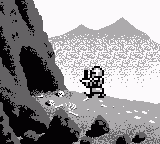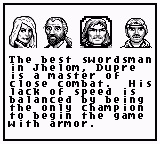Retro Replay Review
Gameplay
Ultima: Runes of Virtue distills the core action‐RPG elements of the Ultima series into a compact Game Boy experience. You guide your chosen hero through eight dungeons, each themed around a missing virtue runestone. Combat is real‐time and straightforward: tap the attack button to swing your sword or staff, hold it to charge up a stronger strike, and use your special abilities to solve puzzles or fend off tougher enemies. As you progress, you’ll collect keys, potions, and treasure that enhance your stats and open new pathways.
(HEY YOU!! We hope you enjoy! We try not to run ads. So basically, this is a very expensive hobby running this site. Please consider joining us for updates, forums, and more. Network w/ us to make some cash or friends while retro gaming, and you can win some free retro games for posting. Okay, carry on 👍)
Character variety adds depth to the gameplay loop. At the outset you select from Shamino the ranger, Dupre the swordsman, Iolo the bard, or Mariah the mage. Each brings a distinct playstyle—Shamino’s ranged shots, Dupre’s powerful melee attacks, Iolo’s crowd‐control melodies, and Mariah’s elemental spells—so replaying the campaign with different heroes keeps encounters fresh. On higher difficulty modes, you’ll need to master each character’s strengths and manage limited resources to survive.
Three difficulty tiers—Novice, Veteran, and Lord British—cater to newcomers and seasoned Ultima fans alike. In Novice mode, health pickups are generous and enemy damage is forgiving. Progressing to Veteran and Lord British ramps up challenge with tougher foes, scarcer healing items, and trickier dungeon puzzles. This scaling system ensures that Runes of Virtue remains approachable for younger players while still testing the mettle of RPG veterans.
Graphics
Given the Game Boy’s hardware limitations, Runes of Virtue delivers surprisingly crisp and expressive sprite work. Each dungeon room is carefully laid out, with walls, floors, and environmental hazards clearly distinguished in monochrome shades. Enemies, from skeletal warriors to golems, sport unique silhouettes that make threat recognition instantaneous even in fast‐paced battles.
The UI is minimalistic and effective. Your health meter, inventory slots, and equipped weapon or spell are displayed unobtrusively along the top of the screen, leaving ample room for the action below. Item icons are recognizable at a glance, preventing fumbling in tense moments, and the map feature automatically reveals rooms you’ve already explored, making backtracking far less tedious than it might be in other portable RPGs.
Despite the single‐color palette, subtle visual flourishes—sparkling treasure chests, flickering torches, and level‐up effects—imbue each dungeon with character. When you recover a virtue runestone, a brief but satisfying animation marks the achievement. These small touches elevate the overall presentation and compensate for the lack of color depth.
Story
The narrative hook of Runes of Virtue is classic Ultima fare: the Black Knight has stolen the eight virtue runestones from Lord British’s castle, upsetting the cosmic balance. Your quest is simple yet compelling—descend into virtue‐themed dungeons, defeat the guardians who pervert each virtue, and restore the runes to their rightful place. While the storyline doesn’t evolve through branching dialogues, its mythic clarity keeps you focused on the ultimate goal.
Fans of the larger Ultima universe will appreciate the familiar names and cameos scattered throughout. Friendly faces like Sherry, Dr. Cat, and the ever‐mischievous Chuckles appear in helpful roles, offering items, hints, or comic relief. These nods to prior Ultima installments add a layer of charm, forging continuity for series veterans and providing teasers for newcomers curious about the greater lore.
Story progression is driven by brief text interludes between dungeons. Although these segments are economical, they effectively convey the thematic battle against vice and the restoration of order. The game’s moderate length—typically three to five hours per playthrough—means the pacing never drags; you’re always one dungeon away from the next major revelation or virtue trial.
Overall Experience
Ultima: Runes of Virtue stands out as one of the more polished action‐RPGs on the Game Boy. Its blend of tight controls, varied character classes, and bite‐sized dungeon crawls makes it ideal for both short bursts and extended sessions. While it lacks the sprawling world map of its PC brethren, it compensates with focused design and replayability through difficulty modes and character choice.
Nostalgia certainly plays a role in its enduring appeal, but the game’s solid mechanics and clear user interface hold up on their own merits. The balance between combat, exploration, and light puzzle‐solving ensures that you’re never stuck for long, and the return of every recovered virtue brings a genuine sense of accomplishment.
For anyone seeking a portable slice of Ultima lore, Runes of Virtue delivers an engaging adventure that respects the series’ moral themes while adapting smartly to handheld constraints. Its approachable difficulty curve and recognizable Ultima trappings make it a recommended pick for collectors and new players alike.
 Retro Replay Retro Replay gaming reviews, news, emulation, geek stuff and more!
Retro Replay Retro Replay gaming reviews, news, emulation, geek stuff and more!









Reviews
There are no reviews yet.